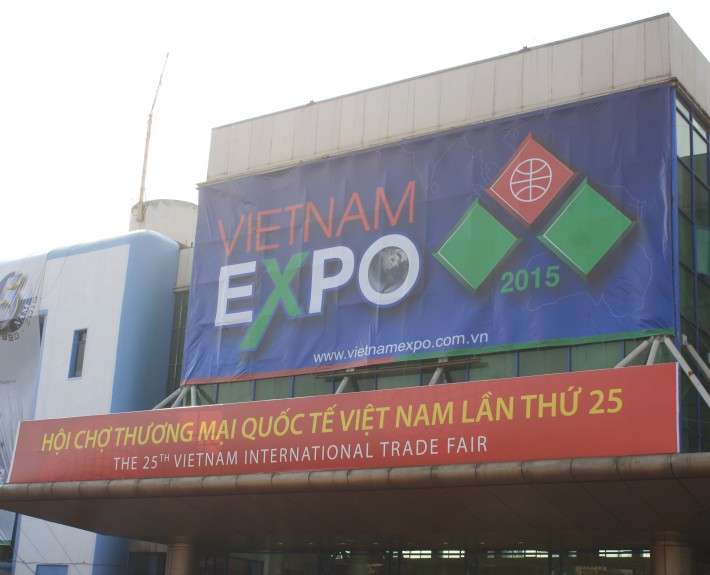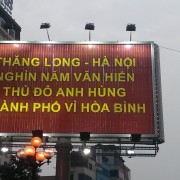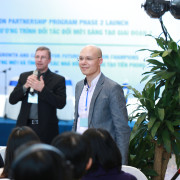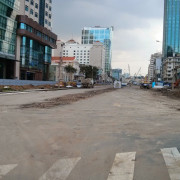Vietnam Expo 2015
Last week we stopped by to check out the 25th annual Vietnam Expo which was held from April 15-18 at the Vietnam Fair Exhibition Center (VEFAC) in Hanoi. The event was hosted by Vietnam’s Ministry of Industry and Trade (MOIT) and directed by the Vietnam Trade Promotion Agency (VIETRADE). Additionally, there were a number of sponsors, organizers, and overseas partners which resulted in 28 countries and territories participating in the event, according to official numbers.
The various exhibitors were spread across three different halls whereas VietBuild Hanoi (the last event we attended at the same location) was spread across both indoor and outdoor areas. Most of the foreign exhibitors seemed to be Korean and Chinese, which was confirmed by official literature. Even though there were more Chinese exhibitors, the Korean exhibitors were organized into their own sections (they had a dedicated area in the main building) which effectively promoted Korean businesses and Korean-Vietnamese economic interests. Surprisingly, there was only one listed Japanese company on the official Vietnam Expo 2015 literature. Furthermore, Cuban exhibitors had a strong showing at the expo, closely followed by Czech companies.
Additionally, there were Russian-origin products, e.g., digital testers for food and other uses. Recently, Prime Minister Medvedev visited Vietnam and announced a new trade deal between the Russian Federation and Vietnam so perhaps there will be more Russian exhibitors at the next Expo. With EU and US sanctions against Russia, this new deal between Russia and Vietnam could prove beneficial to Vietnamese exporters and Russian consumers (and vice versa).
Overall, a variety of beauty and skin care products were on display, mostly of Korean origin as well as some Chinese fashion/clothing trends that were showcased. There were two Korean products that interested us: one was a handmade wooden iPhone 6 case produced in ROK (but could be produced for a much lower cost in Vietnam); and the other was a mobile device charger that doubled as an advertising platform. However, both items seem like they would be better suited in other (developed) markets.
Engaging Exhibitors
We spoke to exhibitors from Nepal, Iran, the Czech Republic, Korea, China, Cuba, DPRK, and Germany, among others. Some had mixed feelings about the Expo; for example, a leather producer from India (but based in China) had paid a Chinese agent $6,000 under the false pretense that the Expo was exclusively for leather (the Indian businessman sold only wholesale). He arrived at the Expo on the first day to find that there were a variety of other goods that were exhibited as well. His attempts to reach his Chinese agent were unsuccessful and the exhibitor left the Expo the next day. This exhibitor described meeting other exhibitors who had been misled, as well as having met other exhibitors who had paid about $1,000 for a similar sized booth.
We met with some exhibitors who expressed confusion about the consumer goods that were present at the event as they had been under the impression that it was to be an industry event (for purchasing and sourcing rather than end-users) which partly reiterated the Indian businessman’s experience. Strangely, there was a large, but mostly empty, Algerian section at the Expo–due to logistical issues as we later found out; we met an Algerian representative who told us that the items for her booth experienced some transportation challenges so she was unable to fill up part of the Algerian section at the event.
We saw individual provinces that were promoted for investment, both by representation of the province (e.g., Quang Nam) and as part of a larger campaign. Furthermore, we met with representatives from more than one company who provided services for Vietnamese companies looking to enter outside markets. Basically, these companies could provide turn-key services for setting up in foreign markets (their respective domestic markets). The majority of the people whom we spoke to—both foreigners and Vietnamese–indicated that they felt there was a lot of opportunity in the Vietnamese market for foreign products as well as opportunity to export Vietnamese products abroad.
At the same time, it seemed difficult for some of the exhibitors to translate the opportunity in the Vietnamese market into success. Some exhibitors had signs in the front of their booths advertising the search for a (new) local partner while others freely expressed their desire to replace their current local partners. Within the first few minutes, exhibitors readily opened up about the challenges of not only attending the Expo but about doing business in Vietnam.
Of three exhibitors whom we spoke to and were actively seeking a new local partner, two of them already had Vietnamese agents. The local Vietnamese agents were described to us as “negative” and “untrustworthy” on two separate occasions. For example, when one exhibitor had informed his local agent of his intended plans to go to the Vietnam Expo, the Vietnamese agent told the foreign exhibitor, “No need, it’s a waste of time.” (Instead of looking forward to seeing his partner.)
In another instance, a different exhibitor shared with us that he suspected his Vietnamese agent was using the foreign brand to command a premium for lower quality parts (substitutes) and that while their organization felt there was a lot of potential in Vietnam, it wasn’t reflected in the small amount of sales coming from the Vietnamese market. (These opinions are from a company that has been operating in China since 1996 so they are not new to entering foreign markets.)
Still, the lack of easily-located quality partners in developing markets is both a hindrance and nothing new. However, with the Expo’s theme of “Cooperation towards the ASEAN Economic Community” (which begins at the end of this year), it remains more important for potential Vietnamese partners to realize the long-term benefits of introducing foreign products, techniques, technology, and other goods and services that Vietnam will need to continue developing into the 21st century.
Key Takeaways
Based on our experiences at the event (over a two-day period), there were several clear and recurring themes:
-The Expo is advertised internationally (to exhibitors) as an industry event—and promoted in other ways as a consumer event;
-Many foreign exhibitors expressed interest in deepening ties with Vietnam and doing more business here;
-It’s a two-way street: many Vietnamese products are suitable for foreign markets—or at least several exhibitors believe so and have formed companies around this thesis; and
-The quality of local agents for newly-entered foreign companies in the Vietnamese market can be greatly improved—but it is challenging to find quality partners.
If you are interested in linking up with a potential Vietnamese partner or would like to learn more about the Vietnam Expo 2015 event then get in touch with us at info@gktagroup.com. The next Vietnam Expo event will be held from April 6-9, 2016.































